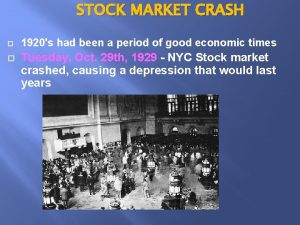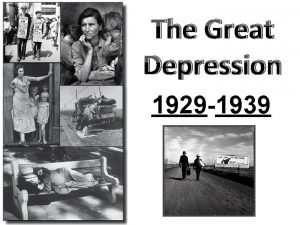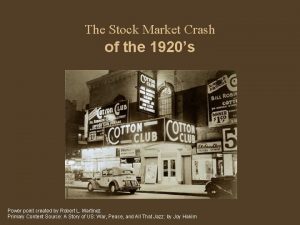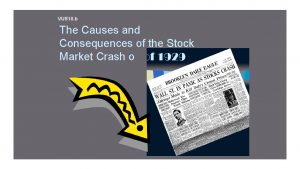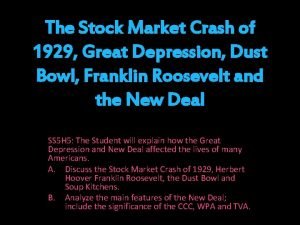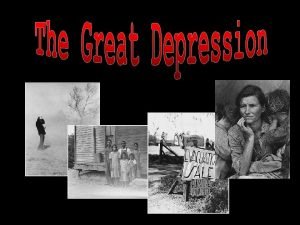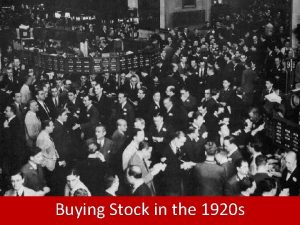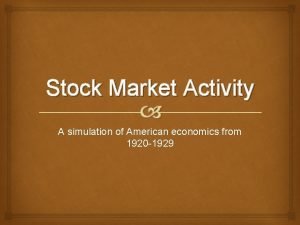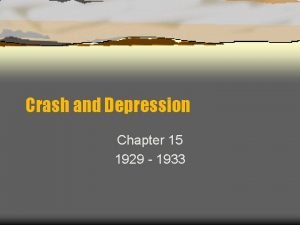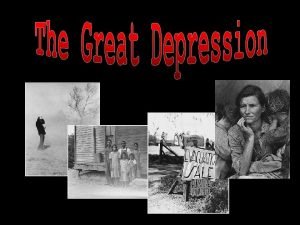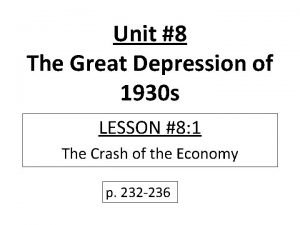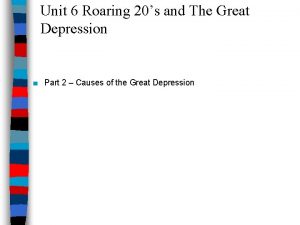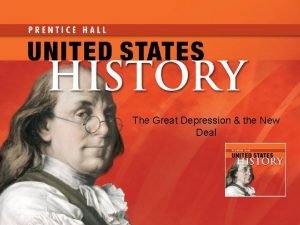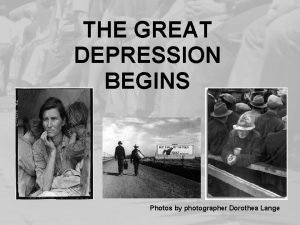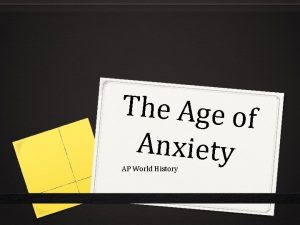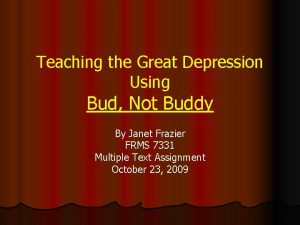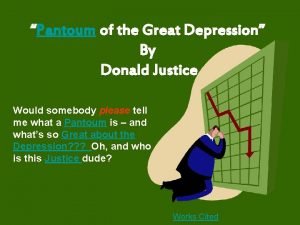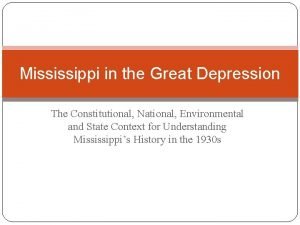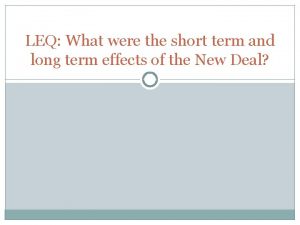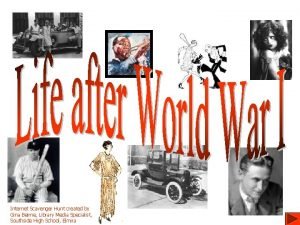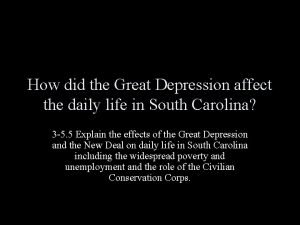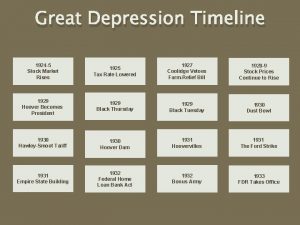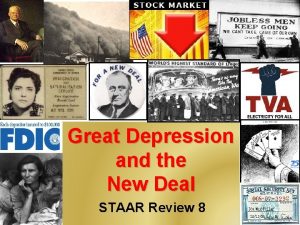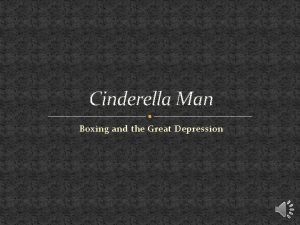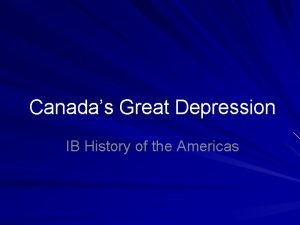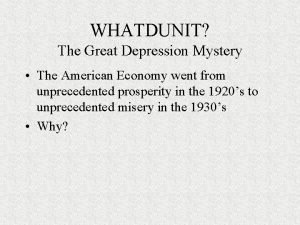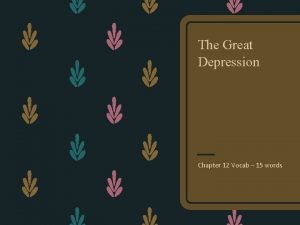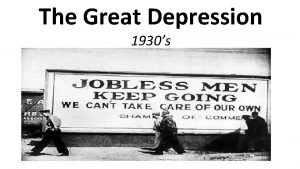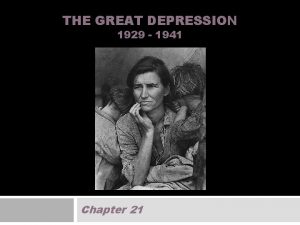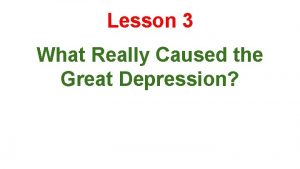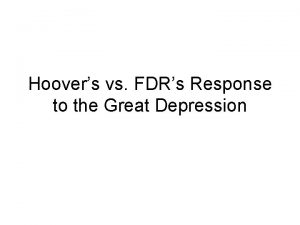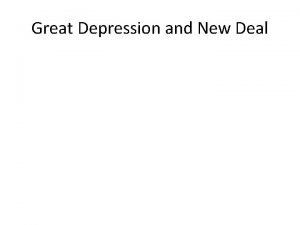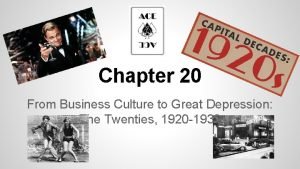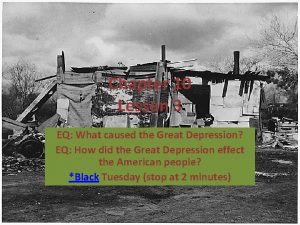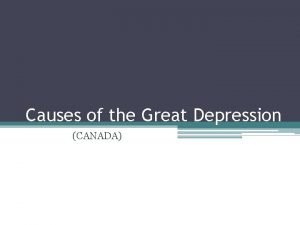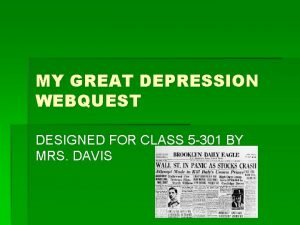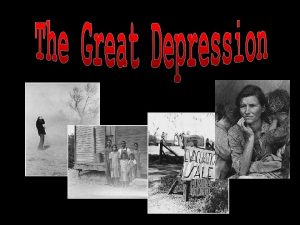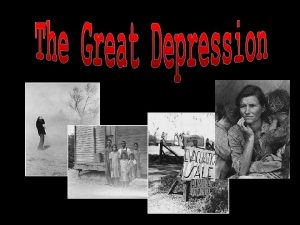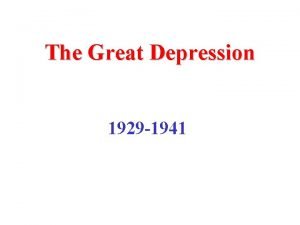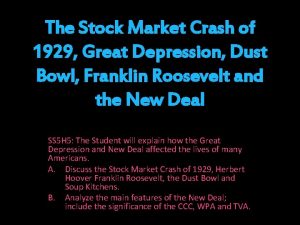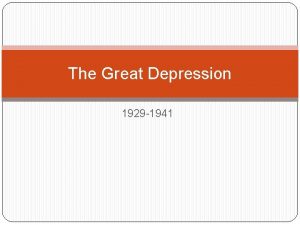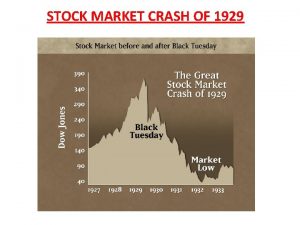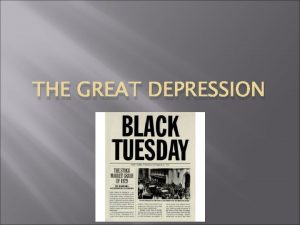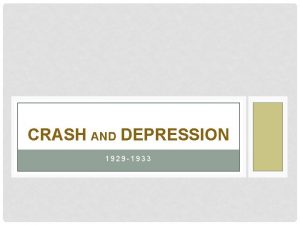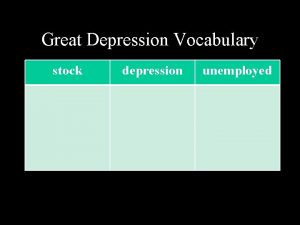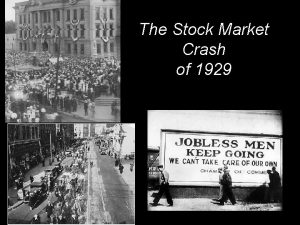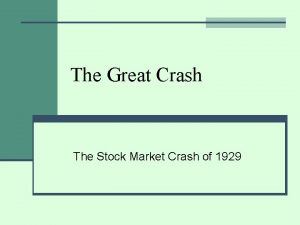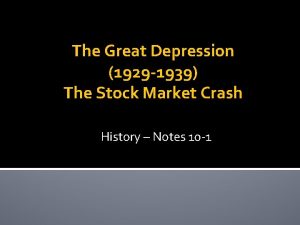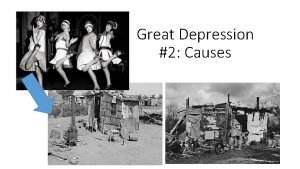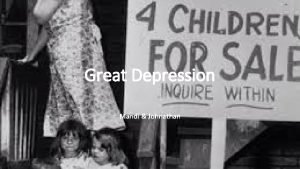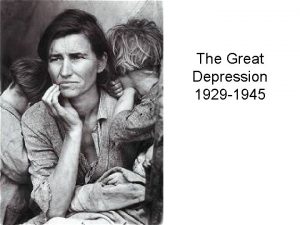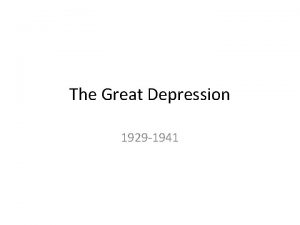The Great Depression Stock Market Crash 1929 Setting




























































- Slides: 60

The Great Depression Stock Market Crash 1929

Setting the Stage for Disaster The Roaring 20’s Decade of prosperity People investing in stocks got wealthy Value of stocks quadrupled. People started borrowing money from banks to invest in capital. • Capital is the tools needed to make raw materials (ex. Machines in factories. ) • • •

The Banking Crises • After the crash of Wall St. , (Oct. 29 th, 1929, Black Tuesday) banks who lent money to investors wanted their money. They didn’t have it. • Many banks also invested in the stock market. • People began to realize that the banks had very little real money on hand. • They ran to collect their money from savings accounts. • Banks begin to fail.

Presidents • Herbert Hoover- Was president when stock market crashed. • Franklin D. Roosevelt- Elected in 1932 and promised Americans he could help get things going in the economy. • Roosevelt promised quick action whereas Hoover believed that the American spirit of Capitalism would eventually end the depression. • The American people listened to Roosevelts “New Deal” for America and elected him in 1932.

Roosevelt’s New Deal For America • President Roosevelt ran for President promising America a “New Deal. ” • The New Deal was Roosevelt’s solution to help lessen the impact of the depression. • For the first time in U. S. History the Government gained control of some aspects of the economy. • Many in America saw Roosevelt’s New Deal as too Socialistic. • While others admired the President for taking quick action to help Americans in great need. • Herbert Hoover believed that Americans could eventually pull themselves out of the economic crises.

Roosevelt’s Banking Holiday • Depositors lost 140 Billion dollars • Banks had no money to lend to small businesses • Checks could not be used for payments. No one could tell which was worthless or not. • Roosevelt closed all banks for three days. • Banks were cautiously re-opened with limits on lending money • Slowly things settled down in the banking system

The FDIC Established • To ensure that depositors would not “run” the banks again, the government established the Federal Deposit Insurance Corp. • If a bank failed the government would reimburse depositors.

The Great Depression • After the stock market crash many businesses failed • Workers were laid off. Eventually 25% of Americans were out of work • Many men hit the road or caught freight trains looking for any way to make money. • Teens also left home in search for Jobs to help their family bring in income.

Images of the Depression

Hoovervilles

Dust Storms

A Farm Foreclosure

Okies Driving to CA.

Migrant Workers

Men looking for jobs

Unemployed workers march

Unemployed in Soup Lines

The Civilian Conservation Corp Clearing Land

C. C. C. Planting Trees

Building Projects

Fighting Fires

Part of Roosevelt’s New Deal • C. C. C. - Civilian Conservation Corp. This New Deal program was initiated to stop soil erosion and stop the decline of timber resources. Men in the C. C. C. camps planted trees, cover for soil and fought fires. • T. V. A. - Tennesse Valley Administration- Formed to find ways to create power, control floods and open navigation on rivers. • W. P. A. - Works Project Administration-

Roosevelt’s Fire Side Chats

Roosevelt’s Fireside Chats • Fireside chats were a series of 33 evening radio broadcasts that occurred between 19331944. • Roosevelt used these broadcasts to promote his New Deal policies. • They were successful and he continued to use these broadcasts to keep America informed during WWII

From Depression To War • Roosevelt’s New Deal did not pull America out of the Great Depression. • Many Critics said it only expanded the role of government in the economy. • Also Americans began to expect the Government to intervene to promote their economic well-being. • This debate continues today. • WWII would pull America from the Great Depression as factories began producing the weapons of war.

WWII The Greatest Generation The Fight for Freedom

The Rise of Fascism • Fascism is a type of government that relies on dictatorial rule and totalitarian rule to maintain rigid control of the people through force and censorship. • After WWI, fascist leaders began to rise to power namely in Italy and Germany. • In Italy, Mussolini slowly rose to power gaining supporters who opposed communism. By 1925, Mussolini was made “head of the government. ” • In Germany another fascists was coming to power. Adolf Hitler and his Nazi party took control by 1933. • Japan would also have fascists leaders. • These fascists states would led the world to war.

Hitler’s Aggression • Adolf Hitler purposely defied the policies of the Treaty of Versailles. • Hitler first took Germany out of the League of Nations and announced his intention to re-arm. • Next he moved troops into a demilitarized zone called the Rhineland. • Later Hitler annexed Austria to Germany (called the Anschluss. ) • Then saying he wanted “living space” Hitler wanted the Sudetenland in Czechoslovakia. • Here 3 million Germans lived and Hitler will be granted this territory at the Munich Conference.


The Great Appeasement • The Munich Conference is often called the great appeasement of Hitler. • The League of Nations did little to stop Hitler’s breaking of the Treaty of Versailles. • At Munich Hitler met with world leaders and promised that after he secured the Sudentenland he wanted no more. • Neville Chamberlin, prime minister of Great Britain, believed Hitler. • After the meeting Chamberlin declared “peace for our time. ” • The leaders at the Munich Conference believed Hitler was satisfied. • However they would learn that a fascists leader cannot be appeased. • Appeasement is attempting to preserve peace by yielding to the demands of an aggressor.

Winston Churchill

“Peace for our time. ”

Hitler Invades Poland • After the Czech. Crises, France and Great Britain began preparing for war. • Both countries vowed to protect Poland. • France and England hoped the Soviet Union would help them with Germany. • However Joseph Stalin would eventually sign a pact with Hitler. This shocked the whole world and guarented the defeat of Poland. (called the Nazi-Soviet Pact) • Hitler invaded Poland on Sept. 1, 1939, with a new kind of warfare called Blitzkreig. WWII had begun. • Blitzkrieg means “lightning war” in German that uses great speed and force. • The airforce was used first to bomb strategic sites and then tanks and armored trucks advanced swiftly. (Panzer units. ) • The Germans took Poland in a month.

Nazi-Soviet Pact

The Fall of France • While Poland was under attack, France moved its army to the Maginot Line, the chain of fortifications guarding France’s frontier. • The Soviets helped the Germans attack Poland from the West. • Hitler’s army first attacked Denmark then Norway. Then moved south to the low countries. (Netherlands, Belgium, etc. ) • Later the Germans outflanked the French Miginot Line and drove toward the English channel trapping French, and British troops at Dunkirk. • After Dunkirk, the French were left alone to fight the Nazis and eventually occupied the heart of France. • Mussolini attacked France from the South. • The French were forced to surrender.

Hitler & Mussolini

The Maginot Line

The Battle of Britain • Before the fall of France, Neville Chamberlin was replaced by Winston Churchill. • Churchill vowed to “fight on to the end. ” • Hitler began bombing Great Britain in September of 1940 first hitting military targets then civilian and industrial targets. • The constant bombing lasted for a solid month. • Churchill rallied the British people by walking the streets after a night of bombing. (esp. London) • He said if we survive Hitler’s Luftwaffe it will be “our finest hour. ” • Great Britain held firm against the bombing and the U. S. helped in the effort.

Battle of Britain

U. S. Involvement • Between 1935 and 1937, the U. S. passed a series of Neutrality Acts which expressed its determination to stay out of the war in Europe. • After WWI the U. S. had a policy of isolationism the belief that the U. S. could shield itself from world conflicts. • However as the Nazis began to threaten world peace, people began to see that isolationism was a failed policy. • Great Britain pleaded with the U. S. for help with the Nazis and in early 1941 congress passed the Lend Lease Act. It authorized the President to supply war materials to Allied Nations. • Later Churchill and FDR met on a British battleship in the North Atlantic and adopted a statement known as The Atlantic Charter. • The Atlantic Charter was written in the spirit of Wilson’s 14 point plan and it basically outlined a policy of freedom for the world.

The Invasion of Russia • After failing to take Great Britain, Hitler turned his focus on Russia. • In June of 1941, the Germans launched a massive attack on the Soviet Union code named Operation Barbrossa. • Hitler wanted Russia for more “living space” and for lebensraum. • As the Germans defeated the Soviets and moved farther into Russia, Stalin ordered a slash and burn. • By November, the German’s had advanced almost to Leningrad and taken major cities but the Soviets refused to _Give-up. • The Germans will attempt to take Stalingrad for its industry and because it was named after the Soviet leader. (A blow for Soviet morale. ) • Stalin ordered the city to be held at all costs. The Soviets counterattack the Germans encircled their army and cut off their supply lines. • The Battle of Stalingrad proved to be the turning point of the war. • The back of the Nazi army was broken as thousands of Germans were killed and taken prisoner. (180, 000)



U. S. Enters WWII • On Dec. 7 th 1941, the Japanese attacked Pearl Harbor, Hawaii. • Why? To get the U. S. Navy out of the way so Japan could take the islands of the Hawaii. • Also relations between the U. S. and Japan were stained over oil and resources. • Once the Japanese took care of the U. S. Navy they began to attack the Southeast Pacific Islands. • They took most of them for their resources. However they would only hold them for a while. • The U. S. began its offensive to take back the islands in May of 1942 under the command of Gen. Douglas Mc. Arthur. • They did an “island hopping campaign” where some islands were taken and others cut off from supplies. This was done all the way to Japan. • One island that was costly to take was Iwo Jima. (Famous Photo taken)






Allies to Victory • The Allied powers, Great Britain, France, Russia and the USA. would slowly take Europe from the Nazis. • It started with the D-Day invasion on June 6 th, 1944. • The D-Day invasion was the largest invasion in world history. • Thousands of troops, equipment and supplies were ferried across the English Channel to the beaches of Normandy. • But once taken, the Allies began to push the Nazis from France all the way to Germany. • Russia attacked from the east. • Hitler was trapped in Berlin and later killed himself in his bunker. • The allies liberated Europe from the Nazi on May 7 th, 1945 known to this day as V-E Day.

D-Day Invasion Map



Hitler’s Final Solution • After the liberation of Europe, the Allies discovered the horror of the Nazi Concentration Camps. • In these camps, the Nazis killed an estimated 6 million Jews in gas chambers. Their bodies were burned in furnaces. • This mass extermination of Jews in Europe started in 1941 and lasted up until the liberation. It is known as The Final Solution (to the Nazis) • The most infamous concentration camps were Dachau in Southern Germany and auschwitz in Poland. • These camps revealed the true evil of Hitler and the Nazi agenda.



WWII Ends • After the defeat of the Nazis, the Allies focused on the empire of Japan. • The island hopping campaign was a success but at a great cost of life and resources. • Once near Japan, a decision had to be made. Do a mass invasion of the Japanese Island or end it with a new weaponthe Atomic Bomb. • The U. S. developed the atomic bomb in a top secret campaign code named The Manhatten Project. Fortunetly they beat the Germans. • President Truman made the decision to drop the first bomb on Hiroshima and a second bomb on Nagisaki.



7 th Period World History ’ 08 -’ 09
 Stock market crash 1929 political cartoons
Stock market crash 1929 political cartoons Stock market crash 1942
Stock market crash 1942 Stock market crash in 1929
Stock market crash in 1929 Fun facts about the stock market crash of 1929
Fun facts about the stock market crash of 1929 Great depression 1929
Great depression 1929 Stock market crash
Stock market crash Black friday stock market crash
Black friday stock market crash Vus.10b when was the stock market crash?
Vus.10b when was the stock market crash? Chicago bulls and bears stock market
Chicago bulls and bears stock market Black thursday
Black thursday 550wgr
550wgr Stock market crash
Stock market crash During the great depression there were many wanderers
During the great depression there were many wanderers Tel-tone stock 1920
Tel-tone stock 1920 Tel tone stock 1929
Tel tone stock 1929 Chapter 15 crash and depression
Chapter 15 crash and depression Market follower
Market follower Market segmentation lesson plan
Market segmentation lesson plan 1939 market crash
1939 market crash Tennessee valley authority new deal
Tennessee valley authority new deal Rarig great depression
Rarig great depression Great depression
Great depression The ingenious quarterback analysis
The ingenious quarterback analysis Foreclosure great depression
Foreclosure great depression Five effects of the great depression
Five effects of the great depression Five effects of the great depression
Five effects of the great depression How did the great depression impact the world
How did the great depression impact the world Great depression ap world history definition
Great depression ap world history definition Bud not buddy
Bud not buddy Donald justice pantoum of the great depression
Donald justice pantoum of the great depression Summary of great depression
Summary of great depression What is deflation
What is deflation Okies great depression
Okies great depression The great depression leq
The great depression leq Roaring twenties scavenger hunt answers
Roaring twenties scavenger hunt answers How did the great depression affect south carolina
How did the great depression affect south carolina What caused the dust bowl
What caused the dust bowl Great depression causes
Great depression causes Mexican repatriation apush
Mexican repatriation apush Boxing during the great depression
Boxing during the great depression Birth rate during the great depression
Birth rate during the great depression Overspeculation great depression
Overspeculation great depression Great depression vocab
Great depression vocab Chapter 14 the great depression begins vocabulary
Chapter 14 the great depression begins vocabulary Great depression
Great depression Http://www.history.com/topics/great-depression
Http://www.history.com/topics/great-depression Hawley-smoot tariff great depression
Hawley-smoot tariff great depression The great depression lesson 2 hardship and suffering
The great depression lesson 2 hardship and suffering Lesson 3 effects of the great depression
Lesson 3 effects of the great depression Hoover v. fdr: responses to the great depression
Hoover v. fdr: responses to the great depression Hoovervilles great depression
Hoovervilles great depression Laissez faire great depression
Laissez faire great depression New woman
New woman Great depression acrostic poem
Great depression acrostic poem Hoovervilles great depression
Hoovervilles great depression What is the message of this political cartoon
What is the message of this political cartoon Pros and cons of the great depression
Pros and cons of the great depression Great depression jeopardy
Great depression jeopardy Chapter 22 the great depression begins
Chapter 22 the great depression begins Great depression
Great depression Great depression webquest
Great depression webquest



